Daughter of Fire <1983>
28th October 2012
Daughter of Fire <1983>– Director: Im Kwon-taek. Starring Park Geun-hyeong <as Hae-joon>, Bang Hee <Yong-nyeo>, and Kim Hee-ra <as Hwa-ryong>. Running Time: 108 minutes. Release Date: November 5, 1983>
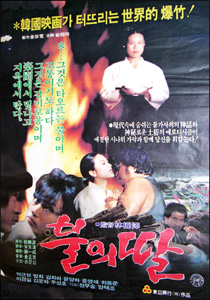 Hae-joon’s life seems to be crumbling around him. The pressures he feels from day-to-day life are compounded because his daughter is seriously ill and in some sort of unresponsive trance. His wife and mother-in-law are extremely religious and are attempting to heal the girl via prayer and they resent that Hae-joon is not joining in on their efforts. And then there are the nightmares. Hae-joon is unable to sleep as he is haunted by images of his mother and the sounds he associates most with her– the sound of the drums and chanting that goes along with traditional exorcisms. It seems Hae-joon’s mother was a shaman and was happiest when performing the rites used to appease spirits. Talking about this situation with a psychologist, Hae-joon is barely able to discuss his mother without his stomach churning and nearly vomiting. This leads to the him to understand that he has to return to his roots in South Jeolla Province to find the source of these feelings. He begins his search with Hwa-ryong, the one-eyed woodcutter who, despite his abuses to the young Hae-joon and Yong-nyeo, was the closest thing the young man had to a father. The old man begins his story from the point he knew it and tells of how he became infuriated when Yong-nyeo was performing a ceremony to put at rest those souls lost at sea. Despite being raped by him, Yong-nyeo appears to forgive Hwa-ryong and stays with him however, she had apparently lost part of her sanity and kept a violent rage bottled up inside. Eventually she had killed herself by walking into a fire. Hwa-ryong, and several other men that Hae-joon interviews, including one that is most likely his father, justify there horrendous treatment of Yong-nyeo as the only method they could think of to save her from herself. She needed saving because in the ’60s, shamanism had been made illegal by the government. To practice it was to risk arrest.
Hae-joon’s life seems to be crumbling around him. The pressures he feels from day-to-day life are compounded because his daughter is seriously ill and in some sort of unresponsive trance. His wife and mother-in-law are extremely religious and are attempting to heal the girl via prayer and they resent that Hae-joon is not joining in on their efforts. And then there are the nightmares. Hae-joon is unable to sleep as he is haunted by images of his mother and the sounds he associates most with her– the sound of the drums and chanting that goes along with traditional exorcisms. It seems Hae-joon’s mother was a shaman and was happiest when performing the rites used to appease spirits. Talking about this situation with a psychologist, Hae-joon is barely able to discuss his mother without his stomach churning and nearly vomiting. This leads to the him to understand that he has to return to his roots in South Jeolla Province to find the source of these feelings. He begins his search with Hwa-ryong, the one-eyed woodcutter who, despite his abuses to the young Hae-joon and Yong-nyeo, was the closest thing the young man had to a father. The old man begins his story from the point he knew it and tells of how he became infuriated when Yong-nyeo was performing a ceremony to put at rest those souls lost at sea. Despite being raped by him, Yong-nyeo appears to forgive Hwa-ryong and stays with him however, she had apparently lost part of her sanity and kept a violent rage bottled up inside. Eventually she had killed herself by walking into a fire. Hwa-ryong, and several other men that Hae-joon interviews, including one that is most likely his father, justify there horrendous treatment of Yong-nyeo as the only method they could think of to save her from herself. She needed saving because in the ’60s, shamanism had been made illegal by the government. To practice it was to risk arrest.
Watching a shamanistic ceremony heralding the annual parting of the sea at Jindo, Hae-joon has an insight regarding his nightmares when he views a group of Christians competing for attention and praising God for the miracle of the tides. Hae-joon realizes that he has always been happiest when watching the ancient Muist practices and feeling the freedom of their dance. He realizes he has been lost since abandoning his own belief system in favor of what was foisted upon him. Returning home, he snatches his daughter away from a particularly intense ‘healing’ prayer service that involved the laying of hands -much to his wife’s embarrassment and dismay. When he confesses to his prim wife that his mother had been a practicing shaman, his candor is met with a slap across the face. Leaving his home, Hae-joon finds his way to a local shrine where a woman calling him ‘my son’ welcomes him with open arms back into the fold.
Shamanism, or Muism, is the earliest form of religion in Korea. It continued when Buddhism and Confusionsim were introduced into the country. Christian missionaries succeeded in surpressing it, but were never able to do away with it completely and many Christian families continue to perform rites to their ancestors upon the anniversary of their deaths or by their tombs at major holidays. In the late 1890’s, the mayor of Seoul, a confirmed Progressive, made shamanism illegal and began having the police round up the practioners, arrest them and destroy their shrines and the images of the gods and spirits. The shamans fought back by hanging pictures of old kings with their gods and, as it was illegal to desecrate the image of a king, policemen also found themselves facing arrest for following orders. The Muists were not so successful in fighting back when Christianity gained a much stronger foothold in the ’60s and certain ceremonies were made illegal. The government wanted to hide many traditional ’superstitions’ from the eyes of foreigners and there were many movies made at this time where the village shaman is depicted as an vestige of the past preventing development and growth such as Kim Ki-young’s excellent film Goryeojang in 1963. By the ’70s however, shamanistic practices made a comeback and today there are several hundred recognized shrines in Seoul. Here in the country there are even more..I live within a stone’s throw of two or three mudang’s homes–recognizable by red flags held high on bamboo posts. There is a television show on cable TV called The Exorcist where a mudang visits people to rid them of evil spirits in their home.. <I do not watch that show after a couple of viewings.. just like shows I’ve seen in the USA like Ghost Labs or Ghost Hunters, they are clearly faked>
However, Hae-joon is not the son of a mudang — a shaman who is possessed by a god to perform healings, exorcisms or make predictions. Instead, his mother was a Seseummu, and given the region and the music with the ceremonies, probably a dangol.  When characteristic of a seseummu is that it is an inherited position. Seseummu were not generally possessed by gods and ghosts in the ceremonies. Instead they summoned the gods through song and dance and their assistant would become possessed so the spirit could communicate with the masses. We see this difference in the first ceremony we witness in the movie– the first woman is a mudang trying to make the spirit possess her. Yong-nyeo then steps in to assist by performing her dance for the spirit. However, this is not just trivia. It explains Hae-joon’s disturbing visions which is a symptom of the illness that often precedes becoming a full-fledged shaman. Normally, shamans are women but men can also become shamans. It also explains clearly Hae-joon’s daughter illness. She is undergoing ‘Shinbyeong’ in which her body is prepared by the gods or spirits. It is a condition that can last a decade or more. From the premise and stance of the movie, we can guess that all the laying of hands and faith healers Hae-joon’s wife can summon will have absolutely no effect on the afflicted child until she can embrace her destiny.
When characteristic of a seseummu is that it is an inherited position. Seseummu were not generally possessed by gods and ghosts in the ceremonies. Instead they summoned the gods through song and dance and their assistant would become possessed so the spirit could communicate with the masses. We see this difference in the first ceremony we witness in the movie– the first woman is a mudang trying to make the spirit possess her. Yong-nyeo then steps in to assist by performing her dance for the spirit. However, this is not just trivia. It explains Hae-joon’s disturbing visions which is a symptom of the illness that often precedes becoming a full-fledged shaman. Normally, shamans are women but men can also become shamans. It also explains clearly Hae-joon’s daughter illness. She is undergoing ‘Shinbyeong’ in which her body is prepared by the gods or spirits. It is a condition that can last a decade or more. From the premise and stance of the movie, we can guess that all the laying of hands and faith healers Hae-joon’s wife can summon will have absolutely no effect on the afflicted child until she can embrace her destiny.
The movie is quite clear in its position of calling for a return, or at least acceptance, of the traditional practices. This is obvious by the detail and care in filming the beauty of the traditional ceremonies and costumes. And the bright colors and joy of those costumes and songs are contrasted sharply the somber clothes, faces and hymns of the Christians. Hae-joon’s wife and inlaws are joyless, narrow-minded and unforgiving. The Christian protestors are drab and dull in comparison to the events around them. And the laying of hands during the faith healing is strongly equated with fakery and showmanship and Hae-joon’s comes to believe it is a false religion, unsuitable for the mental health of Korea. It is no accident that he at first consults a psychologist when he is undergoing his visions. It was predicted by Christians and intellectual writers in the early ’80s that psychology would come to explain much of the phenomenon formerly attributed to ghosts and spirits.
The movie itself takes work to get through. There is a lot of talking and very little action. Even the discussed self-immolation of Yong-nyeo is not depicted. But it does present an interesting arguement that would have been new at the time this film was made and flew in the face of decades of teaching and conditioning. Unfortunately, this movie is not available on DVD. I was able to see it on Hana TV. With the interest in Im Kwon-taek, however, it does have a better possibility than many older films of being released on DVD.

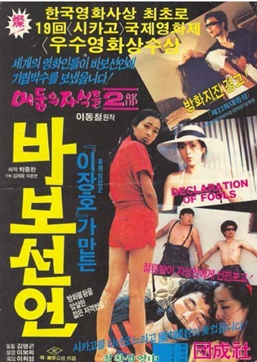
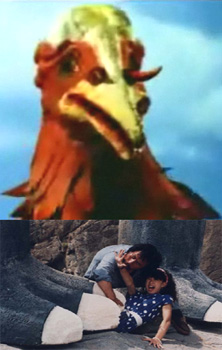

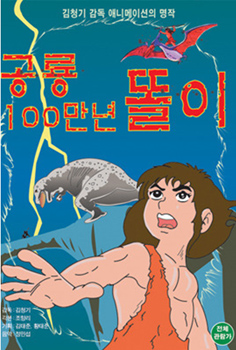
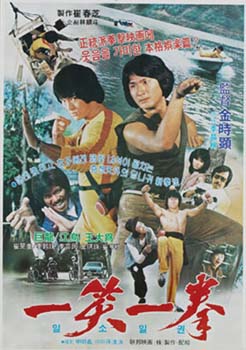 A few weeks ago, I ordered a few films by director Kim Shi-hyeon that I had found on a DVD site based in Hong Kong. These films are not available on DVD in Korea and I thought it would be a good chance to learn about a stage of Korean film history that I know woefully little about– The Hong Kong co-productions and especially the action ‘kung-fu’ films. In the mid-late seventies, Hong Kong cinema was king and enjoying popularity around the world. Korea was also taken with the action films coming out of its southern neighbor. Movies like Bruce Lee’s Enter the Dragon and Jackie Chan’s Drunken Master were very influential and are still remembered fondly–In fact, Drunken Master 2 was on television earlier today (no, I didn’t watch it). Running into trouble with the government, master director Shin Sang-ok relocated his company, Shin Productions, to Hong Kong and many other directors and actors saw the chance to work in Hong Kong. Dozens of films were made of varying quality and stars were born like the Bruce Lee look-alike Geo Ryong aka Dragon Bruce Lee aka Moon Geo-ryong. Geo Ryong gained quite a bit of fame and his career is easy to track. But the fact that these films and the actors in them are listed under so many different names, researching them is quite a chore.
A few weeks ago, I ordered a few films by director Kim Shi-hyeon that I had found on a DVD site based in Hong Kong. These films are not available on DVD in Korea and I thought it would be a good chance to learn about a stage of Korean film history that I know woefully little about– The Hong Kong co-productions and especially the action ‘kung-fu’ films. In the mid-late seventies, Hong Kong cinema was king and enjoying popularity around the world. Korea was also taken with the action films coming out of its southern neighbor. Movies like Bruce Lee’s Enter the Dragon and Jackie Chan’s Drunken Master were very influential and are still remembered fondly–In fact, Drunken Master 2 was on television earlier today (no, I didn’t watch it). Running into trouble with the government, master director Shin Sang-ok relocated his company, Shin Productions, to Hong Kong and many other directors and actors saw the chance to work in Hong Kong. Dozens of films were made of varying quality and stars were born like the Bruce Lee look-alike Geo Ryong aka Dragon Bruce Lee aka Moon Geo-ryong. Geo Ryong gained quite a bit of fame and his career is easy to track. But the fact that these films and the actors in them are listed under so many different names, researching them is quite a chore.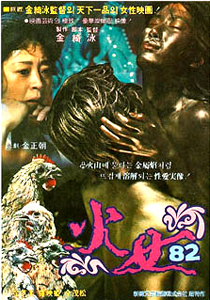
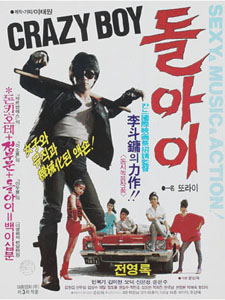 Originally posted April 23, 2009–There are certain things I refuse to do. One of these things is to call the movie Dolai by its original English title of Crazy Boy. It cheapens the movie a little in my opinion. Even worse however is the strange English title the Korean Film Archives is choosing to use for this movie, Imbecile. There is no basis for calling this film by a new English name, when it already has one! The IMDb says this film was also known as ‘The Fool’ which it wasn’t…ever. The Fool is the other random name that the Archives was calling this film until a few months ago. I think the original Korean name, Dolai, works just fine and that is what I will call the movie throughout this review. Dolai is the representative action film of the 1980s, spawning three sequels, one each year following the release of the first and ending with Dolai 4: Dune Buggy in 1988. The success of the movies can almost entirely be credited to lead actor Jeon Yeong-rok and his portrayal of the title character. Jeon, still famous and active today as a singer, has the acting chops to carry the scimpy plot of the film and make it worth watching. The action in the movie draws heavily from the fighting style of Jackie Chan–although the fights are not choreographed quite as well as a Chan film.
Originally posted April 23, 2009–There are certain things I refuse to do. One of these things is to call the movie Dolai by its original English title of Crazy Boy. It cheapens the movie a little in my opinion. Even worse however is the strange English title the Korean Film Archives is choosing to use for this movie, Imbecile. There is no basis for calling this film by a new English name, when it already has one! The IMDb says this film was also known as ‘The Fool’ which it wasn’t…ever. The Fool is the other random name that the Archives was calling this film until a few months ago. I think the original Korean name, Dolai, works just fine and that is what I will call the movie throughout this review. Dolai is the representative action film of the 1980s, spawning three sequels, one each year following the release of the first and ending with Dolai 4: Dune Buggy in 1988. The success of the movies can almost entirely be credited to lead actor Jeon Yeong-rok and his portrayal of the title character. Jeon, still famous and active today as a singer, has the acting chops to carry the scimpy plot of the film and make it worth watching. The action in the movie draws heavily from the fighting style of Jackie Chan–although the fights are not choreographed quite as well as a Chan film.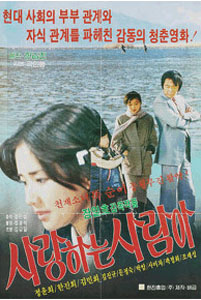 Originally posted June 3, 2009–Last weekend Bong Jun-ho’s Mother made waves at the box office. That film depicted just how strong a mother’s love can be and showed us that some mothers are capable of doing anything to save their children. If we could step back just a couple of decades however, we could see that theme repeated in many different ways. Almost all of those films were melodramas and the relationships between mother and child were often highlighted. There were films where mother would donate their eyes for their children and condemn themselves to live in darkness. There were movies where mothers would admit to crimes they didn’t commit and others where the mother would secretly sacrifice themselves to a life a servitude for the happiness for their children. In The One Love, the mother decides that she will give up her own happiness to see her child well-provided for.
Originally posted June 3, 2009–Last weekend Bong Jun-ho’s Mother made waves at the box office. That film depicted just how strong a mother’s love can be and showed us that some mothers are capable of doing anything to save their children. If we could step back just a couple of decades however, we could see that theme repeated in many different ways. Almost all of those films were melodramas and the relationships between mother and child were often highlighted. There were films where mother would donate their eyes for their children and condemn themselves to live in darkness. There were movies where mothers would admit to crimes they didn’t commit and others where the mother would secretly sacrifice themselves to a life a servitude for the happiness for their children. In The One Love, the mother decides that she will give up her own happiness to see her child well-provided for.